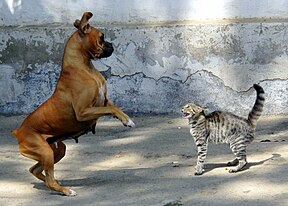Fight-or-flight response
The fight-or-flight or the fight-flight-freeze-or-fawn
This response is recognised as the first stage of the
Name
Originally understood as the "fight-or-flight" response in Cannon's research,
Physiology
Autonomic nervous system
The autonomic nervous system is a control system that acts largely unconsciously and regulates
Sympathetic nervous system
The sympathetic nervous system originates in the spinal cord and its main function is to activate the arousal responses that occur during the fight-or-flight response.[13] The sympathetic nervous system transfers signals from the dorsal hypothalamus, which activates the heart, increases vascular resistance, and increases blood flow, especially to the muscle, heart, and brain tissues.[14] It activates the adrenal medulla, releasing catecholamines that amplify the sympathetic response. Additionally, this component of the autonomic nervous system utilizes and activates the release of norepinephrine by the adrenal glands in the reaction.[15]
Parasympathetic nervous system
The parasympathetic nervous system originates in the sacral spinal cord and medulla, physically surrounding the sympathetic origin, and works in concert with the sympathetic nervous system. It is known as the calming portion of the autonomic nervous system.[16] While the sympathetic nervous system is activated, the parasympathetic nervous system decreases its response. Efferent vagal fibers originating from the nucleus ambiguous fire in parallel to the respiratory system, decreasing the vagal cardiac parasympathetic tone.[17] After the fight or flight response, the parasympathetic system's main function is to activate the "rest and digest" response and return the body to homeostasis. This system utilizes and activates the release of the neurotransmitter acetylcholine.[18]
Reaction
The reaction begins in the
The initial response and subsequent reactions are triggered in an effort to create a boost of energy. This boost of energy is activated by epinephrine binding to
Catecholamine hormones, such as
Function of physiological changes
The physiological changes that occur during the fight or flight response are activated in order to give the body increased strength and speed in anticipation of fighting or running. Some of the specific physiological changes and their functions include:[24][25][26]
- Increased blood flowto the muscles activated by diverting blood flow from other parts of the body to make taking quick action easier.
- Increased blood pressure and heart rate enhance cardiac output in order to supply the body with more energy.
- Increased blood sugar (glucose) and fats secreted by the liver to provide the body with extra fuel.
- Increased respiration to supply the oxygen necessary to help burn the extra glucose.
- The blood clotting function of the body speeds up in order to prevent excessive blood loss in the event of an injury sustained during the response.
- Increased muscle tension in order to provide the body with extra speed and strength, which can result in trembling or shaking until the tension is released.
- The pupils dilate to let in more light, allowing for better vision of the body's surroundings.
Emotional components
Emotion regulation
In the context of the fight or flight response, emotional regulation is used proactively to avoid threats of stress or to control the level of emotional arousal.[27][28]
Emotional reactivity
During the reaction, the intensity of emotion that is brought on by the stimulus will also determine the nature and intensity of the behavioral response.[29] Individuals with higher levels of emotional reactivity may be prone to anxiety and aggression, which illustrates the implications of appropriate emotional reaction in the fight or flight response.[30][31]
Cognitive components
Content specificity
The specific components of cognitions in the fight or flight response seem to be largely negative. These negative cognitions may be characterised by: attention to negative stimuli, the perception of ambiguous situations as negative, and the recurrence of recalling negative words.[32] There also may be specific negative thoughts associated with emotions commonly seen in the reaction.[33]
Perception of control
Perceived control relates to an individual's thoughts about control over situations and events.[34] Perceived control should be differentiated from actual control because an individual's beliefs about their abilities may not reflect their actual abilities. Therefore, overestimation or underestimation of perceived control can lead to anxiety and aggression.[35]
Social information processing
The social information processing model proposes a variety of factors that determine behavior in the context of social situations and preexisting thoughts.[36] The attribution of hostility, especially in ambiguous situations, seems to be one of the most important cognitive factors associated with the fight or flight response because of its implications towards aggression.[37]
Other animals
Evolutionary perspective
An evolutionary psychology explanation is that early animals had to react to threatening stimuli quickly and did not have time to psychologically and physically prepare themselves.[38] The fight or flight response provided them with the mechanisms to rapidly respond to threats against survival.[39][40]
Examples
A typical example of the stress response is a grazing
In July 1992, Behavioral Ecology published experimental research conducted by biologist Lee A. Dugatkin where guppies were sorted into "bold", "ordinary", and "timid" groups based upon their reactions when confronted by a smallmouth bass (i.e. inspecting the predator, hiding, or swimming away) after which the guppies were left in a tank with the bass. After 60 hours, 40 percent of the timid guppies and 15 percent of the ordinary guppies survived while none of the bold guppies did.[41][42]
Varieties of responses
This section needs additional citations for verification. (October 2016) |

Animals respond to threats in many complex ways. Rats, for instance, try to escape when threatened but will fight when cornered. Some animals stand perfectly still so that predators will not see them. Many animals freeze or play dead when touched in the hope that the predator will lose interest.
Other animals have alternative self-protection methods. Some species of cold-blooded animals change color swiftly to camouflage themselves.[43] These responses are triggered by the sympathetic nervous system, but, in order to fit the model of fight or flight, the idea of flight must be broadened to include escaping capture either in a physical or sensory way. Thus, flight can be disappearing to another location or just disappearing in place, and fight and flight are often combined in a given situation.[44]
The fight or flight actions also have polarity – the individual can either fight against or flee from something that is threatening, such as a hungry lion, or fight for or fly towards something that is needed, such as the safety of the shore from a raging river.
A threat from another animal does not always result in immediate fight or flight. There may be a period of heightened awareness, during which each animal interprets behavioral signals from the other. Signs such as paling, piloerection, immobility, sounds, and body language communicate the status and intentions of each animal. There may be a sort of negotiation, after which fight or flight may ensue, but which might also result in playing, mating, or nothing at all. An example of this is kittens playing: each kitten shows the signs of sympathetic arousal, but they never inflict real damage.
See also
- Acute stress reaction
- Anxiety
- Anxiety disorder
- Apparent death
- Body reactivity
- Coping (psychology)
- Defense physiology
- Domestication of the dog
- Emotional dysregulation
- Freezing behavior
- Generalized anxiety disorder
- Escape distance
- Hypothalamic–pituitary–adrenal axis
- Panic attack
- Phobia
- Rest and digest
- Social anxiety
- Social anxiety disorder
- Tend and befriend
- The Relaxation Response
- Vasoconstriction
- Yerkes–Dodson law
- Reflex syncope
- Hypervigilance
Notes
- The American Journal of Physiology.
References
- ^ ISBN 978-1-4928-7184-2.
- ISBN 978-0-393-00205-8.
- ^ a b Walter Bradford Cannon (1915). Bodily changes in pain, hunger, fear, and rage. New York: Appleton-Century-Crofts. p. 211.
- S2CID 38807605.
- ^ Walter Bradford Cannon (1915). Bodily Changes in Pain, Hunger, Fear and Rage: An Account of Recent Researches into the Function of Emotional Excitement. Appleton-Century-Crofts.
- ^ "Adrenaline, Cortisol, Norepinephrine: The Three Major Stress Hormones, Explained". Huffington Post. April 19, 2014. Retrieved 16 August 2014.
- ^ Kwon, Diana. "Fight or Flight May Be in Our Bones". Scientific American. Retrieved 2020-06-22.
- ^ "Bone, not adrenaline, drives fight or flight response". phys.org. Retrieved 2020-06-22.
- ^ Gozhenko, A; Gurkalova, I.P.; Zukow, W; Kwasnik, Z (2009). PATHOLOGY – Theory. Medical Student's Library. Radom. pp. 270–275.
- S2CID 240856695.
- S2CID 8430710. Retrieved 31 May 2021.
- ^ Schmidt, A; Thews, G (1989). "Autonomic Nervous System". In Janig, W (ed.). Human Physiology (2 ed.). New York, NY: Springer-Verlag. pp. 333–370.
- ^ Myers, David G.; DeWall, C. Nathan (2021). Psychology (13 ed.). MacMillan Publishing. p. 422.
- PMID 26062169.
- ^ Chudler, Eric. "Neuroscience For Kids". University of Washington. Retrieved 19 April 2013.
- ^ Myers, David G.; DeWall, C. Nathan (2021). Psychology (13 ed.). MacMillan Publishing. p. 422.
- PMID 26062169.
- ^ Chudler, Eric. "Neuroscience For Kids". University of Washington. Retrieved 19 April 2013.
- ^ Margioris, Andrew; Tsatsanis, Christos (April 2011). "ACTH Action on the Adrenal". Endotext.org. Archived from the original on 6 March 2013. Retrieved 18 April 2013.
- PMID 12909458.
- ^ King, Michael. "PATHWAYS: GLYCOGEN & GLUCOSE". Washington University in St. Louis.
- ^ "HOW CELLS COMMUNICATE DURING THE FIGHT OR FLIGHT RESPONSE". University of Utah. Archived from the original on 8 August 2013. Retrieved 18 April 2013.
- ^ ISBN 978-0-393-97767-7.
- ^ Stress Management for Health Course. "The Fight Flight Response". Retrieved 19 April 2013.
- ^ Olpin, Michael. "The Science of Stress". Weber State University. Archived from the original on 2017-11-20. Retrieved 2013-04-25.
- ^ Myers, David G.; DeWall, C. Nathan (2021). Psychology (13 ed.). MacMillan Publishing. p. 422.
- PMID 20622981.
- .
- .
- S2CID 14382059.
- PMID 14633062.
- S2CID 28911747.
- ^ Beck, Aaron (1979). Cognitive Therapy and the Emotional Disorders. United States: Penguin Books.
- PMID 16487599.
- S2CID 11239252.
- .
- PMID 7363732.
- PMID 24691569.
- ^ Grohol, John. "What's the purpose of the fight or flight response?". Archived from the original on 23 March 2013. Retrieved 18 April 2013.
- S2CID 25072963.
- . Retrieved September 9, 2020.
- ISBN 978-0-679-74674-4.
- ^ Gill, A.C. (2004). Revision of the Indo-Pacific dottyback fish subfamily Pseudochrominae (Perciformes: Pseudochromidae). Smithiana Monographs. pp. 1–123.
- PMID 30827896.
Further reading
- Sapolsky, Robert M., 1994. Why Zebras Don't Get Ulcers. W.H. Freeman and Company.
 This article incorporates public domain material from the United States Government
This article incorporates public domain material from the United States Government
External links
 Media related to Fight-or-Flight Response at Wikimedia Commons
Media related to Fight-or-Flight Response at Wikimedia Commons


